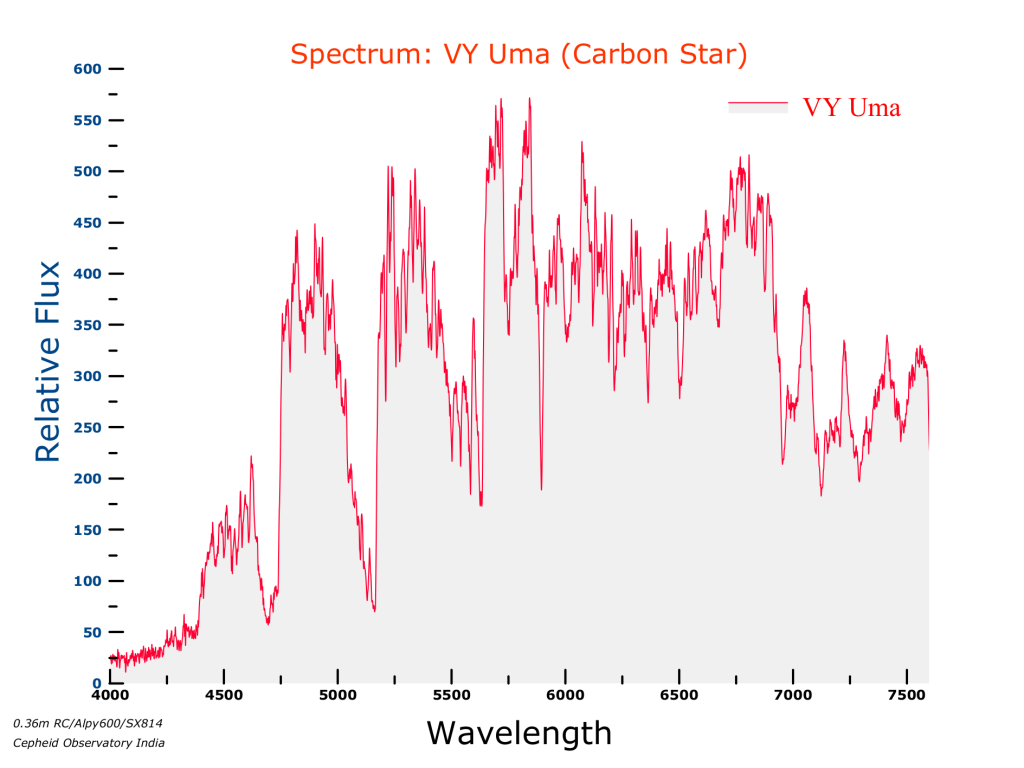Carbon stars are typically evolved cool giants with some circumstellar material in the form of shells, soot, disks, or clouds. Carbon compounds are present in the photosphere after a star enters the red-giant evolutionary phase, when heavy elements (such as carbon) are dredged up from the stellar interior. For carbon features to form in the stellar photosphere, the C/O ratio is > 1, where C and O are the number of carbon and oxygen atoms present in the star. The C2 Swan bands are the dominate optical spectral features. Other strong features include C3, CN, CH, SiC2, CaII and there is often a strong NaD line.
Classical carbon stars are classified into the N and R series, where the N series stars are older stars that show s-process element (Ba, Sr) enhancement over the R stars. The CH stars are high-velocity Population II halo carbon stars, with enriched CH. An abundance index of C2 is also needed to describe a measure of excess carbon over oxygen. C2x, where x indicates increasing band strength from 1 to 8.
Another classification scheme (Yamashita 1975) uses designations for temperature and carbon band strength, such as C7,3. The first number indicates decreasing temperature from 0 to 9, as is the standard scheme for other spectral types. The second number indicates increasing strength of the carbon bands, from 1 to 5.
Some presumed giant C stars were seen to have high proper motions, and coupled with low luminosity, were determined to be the elusive dwarf carbon (dC) star. See Paul Green’s excellent papers on the dC’s.
RCrB and HdC stars are hydrogen deficient supergiant carbon stars. They likely formed from giants that have shed ALL of their hydrogen in the AGB stage, or were possibly created from the merger of white dwarfs. RCrB stars are variable due to circumstellar clouds of sooty carbon grains, and from pulsations(?), whereas typical HdC stars are not variable. These stars have unusual optical spectra, but will show weak CH and Balmer hydrogen lines, and strong HeI emission. These stars recently experienced a final He-shell flash.
Examples include RCrB, RYSgr, XXCam, MVSgr, DYPer, and HD182040 (non-variable).
Carbon features also make an appearance in the DQ class of white dwarfs, and carbon features are common in the spectra of comets.
Some of my favorite carbon star features include (in Angstroms): 3880Å CN (STRONG in comets), 4056Å C3 complex (STRONG in comets), 4217Å CN, 4380Å C2 Swan, 4738Å C2 Swan, 5165Å C2 Swan (STRONG), 5635Å C2 Swan, 6122Å C2 Swan, 4554Å BaII, 4607Å SrI
Also look for the SiC2 bands at 4581Å, 4640Å, 4867Å, 4906Å, 4977Å.
Note that the molecular carbon bands have a reverse profile than that of TiO, that is the carbon bands start with a sharp bandhead edge at the red end of the band and then taper off towards the blue. (With an exception of the SiC2 bands, which taper off towards the red!)
Credit: https://lweb.cfa.harvard.edu/~pberlind/atlas/htmls/cstars.html
https://lweb.cfa.harvard.edu/~pberlind/atlas/htmls/carboncat.html

